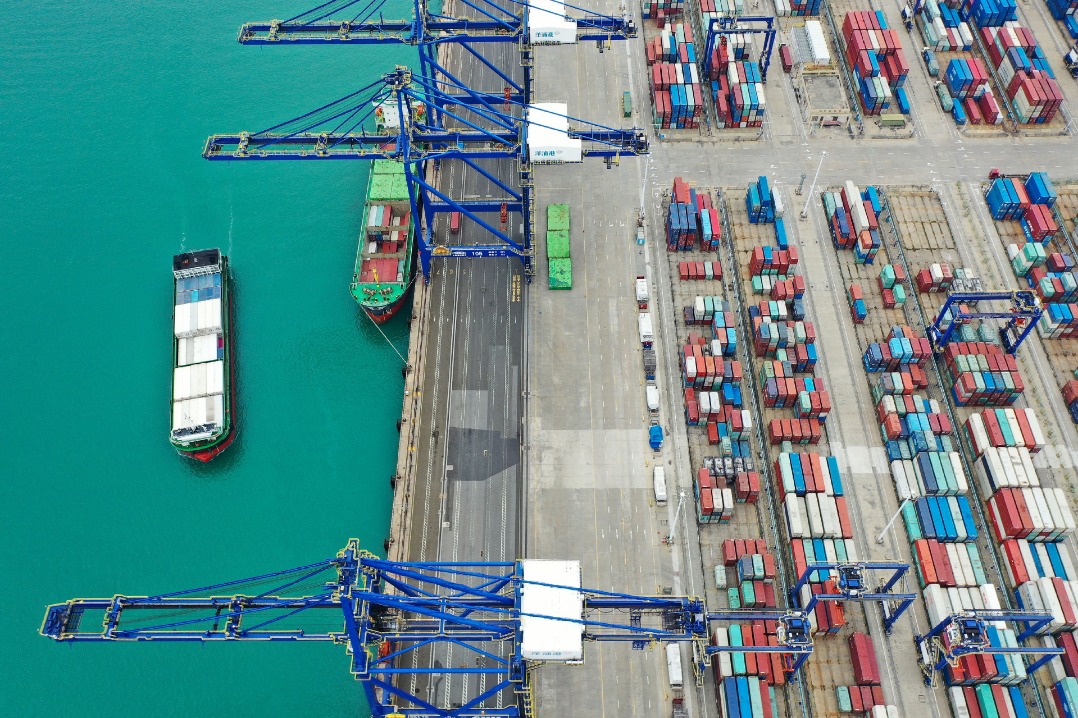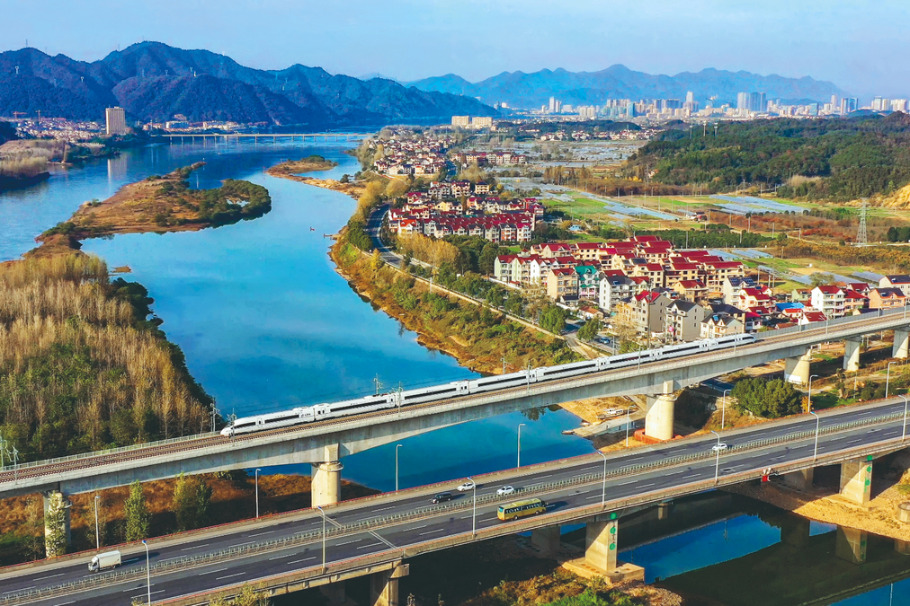China's growth helps boost global recovery
By Yao Yuxin | chinadaily.com.cn | Updated: 2021-06-11 08:32

Editor's note: In a report issued on June 8, the World Bank has forecast that China's economic growth could reach 8.5 percent this year. Martin Raiser, the World Bank' country director for China, shares his views on the Chinese economy with China Daily's Yao Yuxin. Excerpts follow:
Q1: Many international organizations believe China's economic growth could be more than 8 percent in 2021, even though the Chinese government has set the growth target at 6.5 percent. Why has China set a lower GDP growth target?
A: Well, China's target is at least 6.5 percent or above. So it could be 8.5 percent. That would be quite consistent with our forecast. I don't want to speculate on the reasons for China setting the target this way, but I think the signal is pretty clear. Maximizing growth in a year in which China is showing the full recovery from the COVID-19 pandemic is not the most important goal.
Other things have higher priority, dealing with the risks that have accumulated as a result of the increase in debt in the system, and going back to some of the structural changes that China needs to confront, to sustain growth over the medium term, those are more important priorities, and I think that's what the government target signals.
And so, it's basically a reflection of the recovery, and what China will achieve in 2021 is a full recovery from the COVID pandemic. And that is obviously very welcome.
Q2: How do you define "high-quality growth"? And why does China need high-quality growth?
Well, China is, I think, at an important juncture in its development.
The census shows that the population growth in China has been declining, and we expect that the actual population and the labor force will start declining sometime over the course of the next decade. What that means is that China can no longer rely on extensive growth of its population and its labor force to power economic growth.
And we see the same thing in the case of investment. China has had very high savings and investment rates, but as we analyzed in a joint report with the National Development and Reform Commission that came out in 2019, the returns on this investment have been declining. And so China needs to find new drivers of growth, and one way to interpret "quality growth" is essentially that this is about finding these new drivers.
What could that mean? Investing more in human capital, investing more in innovation, making sure that productivity grows, making sure that inefficiencies that still abound can be overcome, that even the smaller enterprises can benefit from new technologies, can hire more productive people.
So those kind of reforms are now what is needed. And of course the environment, making sure that growth is compatible with China's climate commitments. These are all aspects of quality growth and it will make the life of Chinese citizens better, but it will also allow China to sustain economic growth into the future.
Q3: What role high-quality growth can play in achieving the goals of the 14th Five-Year Plan (2021-25)?
I think we're seeing elements of the shift in the drivers of growth in the 14th Five-Year Plan, for instance, we see some emphasis on improving social spending on making sure that education and health services in rural areas are upgraded.
That's an important part of what I was saying when I spoke about investing in human capital. We also see continued attention to environmental issues, and of course, we see strong attention of the 14th Five-Year Plan on innovation, trying to boost China's capacity for productivity growth.
So these are elements of what you could call "quality growth". In many of these areas, we would like to see more details, the 14th Five-Year Plan gives the sense of the direction, but clearly the more detailed sectoral plans are going to give us a lot more of the details that we want to see, to be able to evaluate other policies.
Q4: What policies can help China achieve the goals you have in mind?
Well, I mentioned a few already, I think investment in human capital, greater attention to the environment, putting a price on carbon would be a good idea. The emissions trading system that's starting up in the power sector is a start, but it should be expanded to the rest of the economy.
And then I think, reducing the inefficiencies I mentioned. So if you look at the productivity of the most productive Chinese firms, they're pretty good. They're almost at the world standard and in some cases they're better than other countries. But for all of these champions, there are many small and medium enterprises that have been struggling during the pandemic, that generally find it more difficult to access capital and to invest and that as a result are not very productive.
Same thing in the labor market. The most productive jobs, the best jobs are going to be in the coastal cities. That's where the innovation is taking place. That's where services are developing rapidly. But people cannot easily move to the coastal cities. There are still some restrictions on the movement of labor. So progressively getting rid of some of those restrictions in factor markets could help China accelerate the process of structural change and achieve more quality growth.
Q5: China has decided to follow a "dual circulation" development paradigm. Why did it have to adopt a new development strategy to boost economic growth? And can China's domestic market be the main driver of the economy?
China is a very large country and it's an increasingly integrated domestic market. Large countries rely less on foreign trade than small countries. Among the large countries, China actually still has a fairly large involvement in international trade.
But clearly, to power its growth into the future, it will not be able to rely on foreign trade as much as it did in the past. Increasing the share of (domestic) consumption in GDP provides a potential opportunity for additional growth in China. So that I think is the reason why the shift towards a greater reliance on the domestic market is important. I think it's consistent with the need to develop new drivers of growth.
It's also consistent with the need to develop the services economy. China is still very reliant on industry and on manufacturing. But most rich countries have a much larger reliance on the services sector. A lot of the innovation happens in services, think of the e-commerce companies in China but also think of Silicon Valley. And so if you want to benefit from some of those technological trends from digitalization you will have to develop your services industry.
And again, the services industry, at least the consumer-end is more domestically focused. Of course, services also contribute inputs into manufacturing. So the distinction between the two is not so clear cut, but these are all elements of why reliance on the domestic market as a source of growth is a good idea. Where China should be careful is that this does not come at the expense of turning inwards, of closing off the economy. But relying on the domestic market as a greater engine for economic growth makes sense.
Q6: This December will mark the 20th anniversary of China joining the WTO. China has promised to keep opening up its economy under "dual circulation". What are the biggest achievements of China's reform and opening-up?
China joining the WTO clearly was a major marker. The decade preceding that was a decade of very intensive structural reforms in preparation for WTO accession. And clearly, China joining the WTO has created lots of opportunities for Chinese companies, but also for China's trading partners.
Today, the WTO is facing major challenges, is facing the need for reform and some of this has to do with the parts that are not so well regulated in the WTO, which are the non-tariff barriers, the things that happen inside the country, like licenses, procurement, access to government contracts, access to finance, subsidies etc.. Here China could contribute to reducing trade tensions by opening up more.
I think if China is serious about dual circulation, meaning greater reliance on the domestic market as an engine of growth, but also greater opening-up to allow other countries, China's trading partners, to benefit from China's domestic market, then I think it should deal with some of these behind-the-border issues, as has been done through, for instance, the foreign investment law that was passed, through the reduction of sectors that are restricted to foreign investment. And there are clearly several areas where China can do more.
So further opening up is critical for China to become a motor for other countries' economic development and contributing to the global post-Covid recovery.
Q7: The Chinese government is promoting free trade areas and pilot free trade zones across the country. How can China better promote high-level opening-up?
I think the free trade zones were an important element of opening-up. And clearly they continue to feature prominently in China's reform catalogue. But as the domestic market in China becomes more and more integrated, at some point you wonder why not extend the policies of the free trade zone to the rest of the country? That would be true opening-up of those sectors that still remain restricted.
Of course, this will happen gradually, but I think as a vision, you'd want to say, now that the domestic market is so integrated, and now that infrastructure connects all parts of China relatively well with one another. Now that you've had 40 years of successful experiments with special economic zones, maybe the time has come to move from special economic zones to broader economic opening-up for the whole market.
And even though China has made huge progress since WTO accession and even in more recent years, there's still room to open up more. And I think the sectors that I mentioned, services, being foremost among them, is a good place to start.
Q8: China has pledged to peak its carbon emissions before 2030 and to achieve carbon neutrality before 2060. How important achieving these goals is for China and the world?
Well, the decarbonization goals of China are a very important part of how the world can reach the temperature goals set in the Paris Agreement. As you know, in Paris, the heads of state committed themselves, the countries committed themselves, to try and to keep the global temperature rise below 2 C and to try and achieve a temperature rise of only 1.5 C. To achieve this, China absolutely has to reach the goal of achieving net-zero emissions before 2060, and peaking emissions before 2030.
Now a big part of the challenge is how you manage that transition, and there are challenges in China, particularly because its energy sector is still so reliant on coal, and so the energy transition is a big part of the challenge that China faces. But there are also big opportunities.
I spoke earlier about the potential that China has to develop its services industry. As you move from industry to services, you have less emissions, because industry is more emission-intensive. Moreover, because China is technologically quite advanced for its level of income it can achieve a decoupling of emissions from GDP at an earlier stage of development, than certainly the US or most European countries have achieved.
So we're looking forward to working with the Chinese authorities in various sectors, in the transportation sector, in the energy sector, in the development of smart cities, in the development of lower emission, low carbon agriculture, in all of these areas. We are working to try and show that China can peak emissions before 2030, maybe as early as 2025.
That should be the ambition because that's going to signal to the rest of the world that this is a huge economic opportunity and that China takes it seriously and it will position China because of its technological capabilities as a provider of green development solutions for other emerging markets.
So what happens in China in the next 10 years is very important for the global climate, and China has a real opportunity to be a leader. And with the goal set by President Xi Jinping, China needs to formulate the implementation policies that make that possible. And that's a big part of what we want to do together with China over the next decade.
One additional point to consider. I think for reaching the 1.5 or even 2 Centigrade goal it's much more important what happens in the next 10 years than what happens between 2050 and 2060.
Why is this? Because emissions are cumulative, whatever you emit in the next 10 years will be up there in the atmosphere. Whatever you can avoid emitting in the next 10 years will not lead to greater global warming. And so I think, what the world has to realize is that this isn't a task for the next leaders. This is something you need to start doing today immediately and extensively and deeply. Otherwise, the 1.5 degrees or the 2 degrees is not going to happen.
And so I think what is encouraging about China's commitments is that it signals that it wants to peak emissions before 2030. That's the important part of that commitment. That's what we need to work on. From a peak, say by 2025, the trajectory from then on down to 2060 is also easier. So we really need to focus on this coming decade. That's the key message.
Q9: So how can China combine these targets into its overall goal of building ecological civilization?
I think ecological civilization offers a very good framework to think about the task of decarbonization. Of course, it's broader than that. It includes attention to bio-diversity. It includes attention to not just carbon emissions or greenhouse gas emissions, but other sources of pollution. But we know that in many ways, a green growth path in line with the goals of ecological civilization is also going to be a less emission-intensive growth path.
And so, the two are highly complementary. And we understand the vision of an ecological civilization really is providing the framework, within which you can think about the path to decarbonization. So we see this as part of the same overall objective.
























